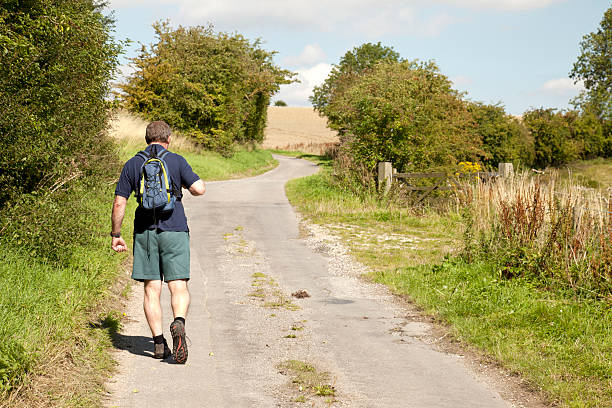It turns out that one of the best ways to guard against chronic low back pain doesn’t require a prescription, expensive gear, or a gym membership. All it takes is a pair of legs and a little over 100 minutes a day.
In a sweeping new study from the Norwegian University of Science and Technology (NTNU), researchers have discovered that people who walk more than 100 minutes daily significantly lower their risk of developing chronic low back pain—one of the most common and costly health conditions in the world. According to the findings, published this week in JAMA Network Open, logging just over an hour and a half of walking each day was linked to a 23% reduction in chronic back pain risk.
The simplicity of the message is startling: put one foot in front of the other, consistently, and you may steer clear of one of the most debilitating afflictions of our time.
A Global Epidemic of Aches
Low back pain is more than a common nuisance. It is a leading cause of disability across the globe, responsible for 7.7% of all years lived with disability. In the United States alone, it ranks among the top drivers of health care spending, draining billions annually from both public and private systems.
Despite its prevalence, treatment options are often fragmented—ranging from medications and physical therapy to surgery. Prevention, when discussed, tends to be vague: maintain physical activity, strengthen your core, don’t sit too much. But rarely have these guidelines been quantified with concrete, everyday targets.
That’s what makes this new research stand out. It translates prevention into something tangible: walking. Not as an abstract goal, but as a measurable, daily activity accessible to nearly everyone.
How the Study Walked the Talk
The team of researchers conducted a large-scale prospective cohort study, drawing on data from over 11,000 adults in the Trøndelag Health Study, one of Europe’s most comprehensive public health surveys. Participants were at least 20 years old and had no history of chronic low back pain at the study’s start between 2017 and 2019.
Each participant wore two tri-axial AX3 accelerometers—one on the thigh and one on the lower back—for seven consecutive days. These advanced motion sensors recorded not just how much they moved, but how intensely. The study tracked daily walking volume (total time spent walking) and walking intensity (the pace and vigor of the movement), offering a detailed picture of each participant’s habitual activity.
The researchers then followed up with the participants from 2021 to 2023, asking about their experience with chronic low back pain, defined as pain persisting for three months or more over the past year.
The results were clear and compelling: Those who walked between 101 and 124 minutes per day had a 23% lower risk of developing chronic low back pain compared to those who walked less. People who walked 125 minutes or more per day fared slightly better, with a 24% lower risk. Even higher walking intensity was linked to reduced risk, but it was the overall walking volume—simply walking longer—that had the most pronounced benefit.
Why Walking Works
To the average person, the idea that walking can fend off back pain might seem counterintuitive—especially since people with sore backs often struggle to move at all. But the science behind it is solid.
Walking promotes circulation to the spinal discs and muscles, helping keep them nourished and resilient. It engages the core and the glutes, stabilizing the pelvis and spine without overloading the joints. It encourages good posture, reduces inflammation, and helps manage weight—all factors that play crucial roles in spinal health.
And perhaps most importantly, walking doesn’t require perfect technique, special supervision, or expensive equipment. It’s the most democratic form of movement we have.
A Call to Public Health
One of the most striking aspects of the study is how it reframes public health messaging. Until now, guidelines for preventing or managing chronic low back pain have encouraged physical activity in general terms. But many people are left wondering what that really means: How much activity? What kind? How often?
This study answers those questions with uncommon clarity. Walking for 100 minutes or more each day, regardless of speed, appears to provide a strong protective effect. And while brisk walking (i.e., higher intensity) certainly adds benefits, it’s the time spent on your feet that seems to matter most.
That finding has powerful implications for health campaigns and everyday behavior. Rather than pushing people into intense exercise regimes they might abandon, it suggests a more realistic goal: just walk more. Take longer strolls. Break up your sitting. Make walking part of your lifestyle.
Beyond the Numbers: A Human Story
Behind the statistics lie millions of people whose lives are shaped daily by pain. For some, chronic back pain means missing work, withdrawing from loved ones, or living on a cocktail of medications with side effects. For others, it becomes a silent battle—an invisible burden that makes even simple pleasures, like picking up a child or sleeping through the night, feel out of reach.
This research offers more than prevention—it offers hope. Hope that something as ordinary as walking the dog, pacing on a phone call, or taking the long way home could be a daily act of resistance against a painful fate.
It also empowers people to take control in a world where medical advice often feels distant or inaccessible. You don’t need a diagnosis to start. You don’t need permission. You just need to move—every day, and a little bit more.
Reference: Rayane Haddadj et al, Volume and Intensity of Walking and Risk of Chronic Low Back Pain, JAMA Network Open (2025). DOI: 10.1001/jamanetworkopen.2025.15592






